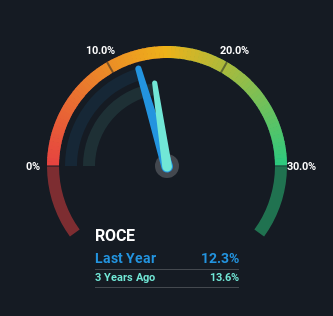There Are Reasons To Feel Uneasy About Dynemic Products' (NSE:DYNPRO) Returns On Capital
Finding a business that has the potential to grow substantially is not easy, but it is possible if we look at a few key financial metrics. Ideally, a business will show two trends; firstly a growing return on capital employed (ROCE) and secondly, an increasing amount of capital employed. Ultimately, this demonstrates that it's a business that is reinvesting profits at increasing rates of return. However, after briefly looking over the numbers, we don't think Dynemic Products (NSE:DYNPRO) has the makings of a multi-bagger going forward, but let's have a look at why that may be.
Understanding Return On Capital Employed (ROCE)
For those who don't know, ROCE is a measure of a company's yearly pre-tax profit (its return), relative to the capital employed in the business. To calculate this metric for Dynemic Products, this is the formula:
Return on Capital Employed = Earnings Before Interest and Tax (EBIT) ÷ (Total Assets - Current Liabilities)
0.12 = ₹294m ÷ (₹4.2b - ₹1.8b) (Based on the trailing twelve months to December 2024).
Thus, Dynemic Products has an ROCE of 12%. In absolute terms, that's a pretty normal return, and it's somewhat close to the Chemicals industry average of 13%.
See our latest analysis for Dynemic Products

Historical performance is a great place to start when researching a stock so above you can see the gauge for Dynemic Products' ROCE against it's prior returns. If you'd like to look at how Dynemic Products has performed in the past in other metrics, you can view this free graph of Dynemic Products' past earnings, revenue and cash flow.
The Trend Of ROCE
When we looked at the ROCE trend at Dynemic Products, we didn't gain much confidence. To be more specific, ROCE has fallen from 23% over the last five years. However, given capital employed and revenue have both increased it appears that the business is currently pursuing growth, at the consequence of short term returns. If these investments prove successful, this can bode very well for long term stock performance.
On a side note, Dynemic Products' current liabilities have increased over the last five years to 43% of total assets, effectively distorting the ROCE to some degree. Without this increase, it's likely that ROCE would be even lower than 12%. What this means is that in reality, a rather large portion of the business is being funded by the likes of the company's suppliers or short-term creditors, which can bring some risks of its own.
The Bottom Line
While returns have fallen for Dynemic Products in recent times, we're encouraged to see that sales are growing and that the business is reinvesting in its operations. And the stock has done incredibly well with a 174% return over the last five years, so long term investors are no doubt ecstatic with that result. So should these growth trends continue, we'd be optimistic on the stock going forward.
On a final note, we found 3 warning signs for Dynemic Products (1 can't be ignored) you should be aware of.
For those who like to invest in solid companies, check out this free list of companies with solid balance sheets and high returns on equity.
New: Manage All Your Stock Portfolios in One Place
We've created the ultimate portfolio companion for stock investors, and it's free.
• Connect an unlimited number of Portfolios and see your total in one currency
• Be alerted to new Warning Signs or Risks via email or mobile
• Track the Fair Value of your stocks
Have feedback on this article? Concerned about the content? Get in touch with us directly. Alternatively, email editorial-team (at) simplywallst.com.
This article by Simply Wall St is general in nature. We provide commentary based on historical data and analyst forecasts only using an unbiased methodology and our articles are not intended to be financial advice. It does not constitute a recommendation to buy or sell any stock, and does not take account of your objectives, or your financial situation. We aim to bring you long-term focused analysis driven by fundamental data. Note that our analysis may not factor in the latest price-sensitive company announcements or qualitative material. Simply Wall St has no position in any stocks mentioned.
About NSEI:DYNPRO
Dynemic Products
Engages in the manufacture and sale of dyes and dye intermediates in India.
Proven track record with adequate balance sheet.
Market Insights
Community Narratives




